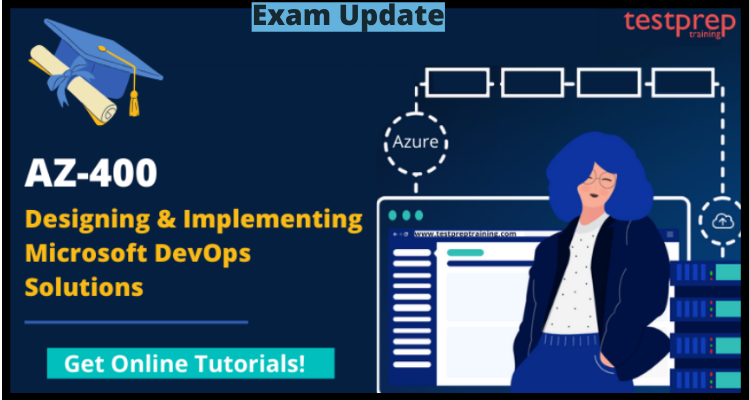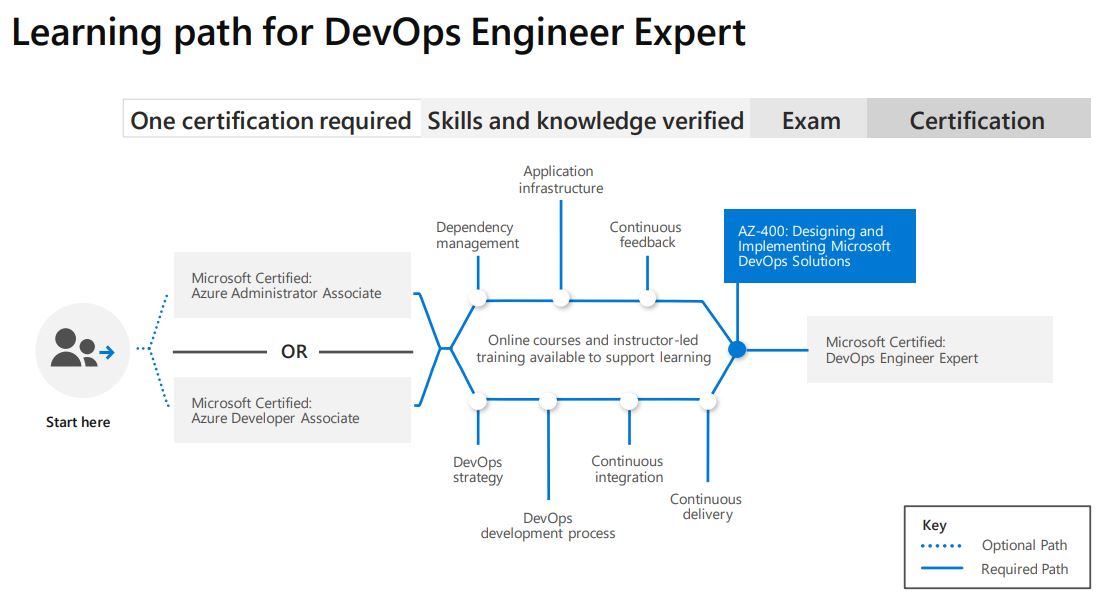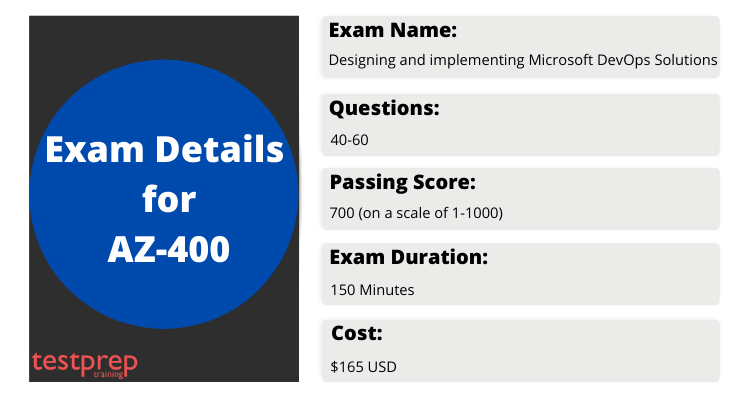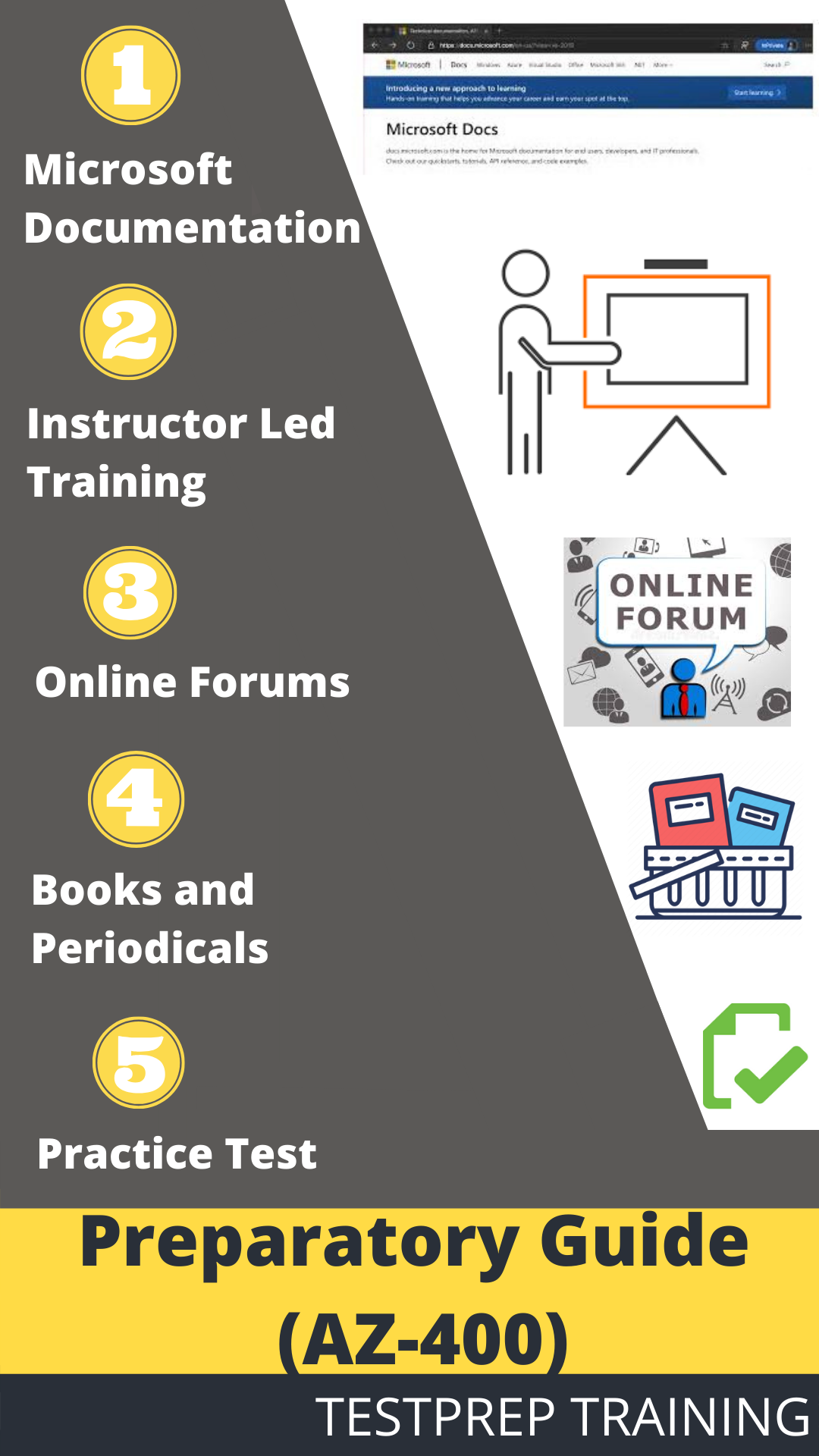Exam AZ-400: Designing and Implementing Microsoft DevOps Solutions

Designing and Implementing Microsoft DevOps Solutions AZ-400 exam is intended for the DevOps professionals who have already received the badge of Azure Developer Associate or Azure Administrator Associate. Microsoft Azure AZ-400 exam measures the ability of the candidate to design a DevOps strategy and implement – DevOps development processes; dependency management; application infrastructure; and continuous integration, delivery, and feedback. The responsibilities of a DevOps professional include:
- Streamlining delivery by optimizing practice
- Improving communications and collaboration
- Creating automation
- Design and implement strategies for application code and infrastructure
Who should take the exam?
Candidates appearing for AZ-400 exam are DevOps professionals who combine people, processes, and technologies to continuously deliver valuable products and services that meet end user needs and business objectives. Some of the important details listed for candidates planning to take this exam includes –
- Subject matter expertise working with people, processes, and technologies to continuously deliver business values
- Ability to design and implementing strategies for collaboration, code, infrastructure, source control, security, compliance, continuous integration, testing, delivery, monitoring, and feedback.
- Familiarity with both Azure administration and development and must be expert in at least one of these areas.
Learning Objectives
Microsoft being a dominant player constantly provides relevant and required documentation to meet the needs of all of today’s diverse learners and therefore, helping them to build a life in the world of cloud computing. As a result, the potential aspirants are easily able to locate the required detailed information along with the subtopics included in each domain.
The AZ-400 certification exam focuses on five key areas:
- Develop an Instrumentation Strategy
- Also, Develop a Site Reliability Engineering (SRE) strategy
- Develop a security and compliance plan
- Manage source control
- Facilitate communication and collaboration
- Define and implement continuous integration
- Define and implement continuous delivery and release management strategy
Microsoft AZ-400 Learning Path
The AZ-400 exam helps candidates to design and implement strategies for application code and infrastructure that allow for continuous integration, testing, delivery, monitoring, and feedback. The AZ-400 exam tests your knowledge across seven different subject areas, and that’s how this AZ-400 learning path is structured.

Exam Format
The Microsoft Azure AZ-400 exam consists of 40-60 questions. However, the AZ-400 exam questions will be multiple choice/ multiple response questions which need to be finished within a time frame of 150 minutes. For AZ-400 passing score, Microsoft states that the candidate has to score at least 700 or more points in order to pass the exam. The AZ-400 certification cost is $165 USD including all the additional taxes. Additionally, the exam is available in four languages, namely English, Japanese, Chinese (Simplified), and Korean.

How to schedule the exam?
The exam measures your ability to design a DevOps strategy and implement the following: DevOps development processes; dependency management; application infrastructure; and continuous integration, delivery, and feedback.
Candidates can schedule the exam with the Pearson VUE. 
Exam Detailed Course Outline
1. Design and implement processes and communications (10–15%)
Design and implement traceability and flow of work
- Design and implement a structure for the flow of work, including GitHub Flow
- Design and implement a strategy for feedback cycles, including notifications and issues
- Design and implement integration for tracking work, including GitHub projects, Azure Boards, and repositories
- Design and implement source, bug, and quality traceability
Design and implement appropriate metrics and queries for DevOps
- Design and implement a dashboard, including flow of work, such as cycle times, time to recovery, and lead time
- Design and implement appropriate metrics and queries for project planning
- Design and implement appropriate metrics and queries for development
- Design and implement appropriate metrics and queries for testing
- Design and implement appropriate metrics and queries for security
- Design and implement appropriate metrics and queries for delivery
- Design and implement appropriate metrics and queries for operations
Configure collaboration and communication
- Document a project by using tools, such as wikis and process diagrams (Microsoft Documentation: Create a wiki for your project)
- Configure release documentation, including release notes and API documentation (Microsoft Documentation: Releases, Releases – List)
- Automate creation of documentation from Git history (Microsoft Documentation: Understand Git history simplification)
- Configure notifications by using webhooks (Microsoft Documentation: Set up notifications for changes in resource data)
- Configure integration between GitHub or Azure DevOps and Microsoft Teams
2. Design and implement a source control strategy (10–15%)
Plan and implement branching strategies for the source code
- Design a branch strategy, including trunk-based, feature branch, and release branch (Microsoft Documentation: Adopt a Git branching strategy)
- Design and implement a pull request workflow by using branch policies and branch protections (Microsoft Documentation: Branch policies and settings)
- Implement branch merging restrictions by using branch policies and branch protections (Microsoft Documentation: About branches and branch policies)
Configure and manage repositories
- Design and implement a strategy for managing large files, including Git Large File Storage (LFS) and git-fat
- Design a strategy for scaling and optimizing a Git repository, including Scalar and cross-repository sharing
- Configure permissions in the source control repository (Microsoft Documentation: Set Git repository permissions)
- Configure tags to organize the source control repository (Microsoft Documentation: Set Git repository settings and policies)
- Recover data by using Git commands (Microsoft Documentation: Git command reference)
- Remove specific data from source control
3. Design and implement build and release pipelines (50–55%)
Design and implement a package management strategy
- Recommend package management tools including GitHub Packages registry and Azure Artifacts
- Design and implement package feeds and views for local and upstream packages (Microsoft Documentation: Upstream sources)
- Design and implement a dependency versioning strategy for code assets and packages, including semantic versioning and date-based (Microsoft Documentation: Implement a versioning strategy, Package versioning)
- Design and implement a versioning strategy for pipeline artifacts (Microsoft Documentation: Implement a versioning strategy)
Design and implement a testing strategy for pipelines
- Design and implement quality and release gates, including security and governance
- Design a comprehensive testing strategy, including local tests, unit tests, integration tests, and load tests
- Implement tests in a pipeline, including configuring test tasks, configuring test agents, and integration of test results
- Implement code coverage analysis
Design and implement pipelines
- Select a deployment automation solution, including GitHub Actions and Azure Pipelines (Microsoft Documentation: Deploy to App Service using GitHub Actions)
- Design and implement a GitHub runner or Azure DevOps agent infrastructure, including cost, tool selection, licenses, connectivity, and maintainability
- Design and implement integration between GitHub repositories and Azure Pipelines
- Develop and implement pipeline trigger rules (Microsoft Documentation: Trigger one pipeline after another)
- Develop pipelines by using YAML (Microsoft Documentation: Create your first pipeline)
- Design and implement a strategy for job execution order, including parallelism and multi-stage pipelines (Microsoft Documentation: Task Parallel Library (TPL), jobs.job.strategy definition)
- Develop and implement complex pipeline scenarios, such as hybrid pipelines, VM templates, and self-hosted runners or agents
- Create reusable pipeline elements, including YAML templates, task groups, variables, and variable groups (Microsoft Documentation: Define variables)
- Design and implement checks and approvals by using YAML environments (Microsoft Documentation: Release deployment control using approvals)
Design and implement deployments
- Design a deployment strategy, including blue/green, canary, ring, progressive exposure, feature flags, and A/B testing (Microsoft Documentation: Progressive experimentation with feature flags)
- Design a pipeline to ensure that dependency deployments are reliably ordered (Microsoft Documentation: Add stages, dependencies, & conditions)
- Plan for minimizing downtime during deployments by using virtual IP address (VIP) swap, load balancing, rolling deployments, and deployment slots (Microsoft Documentation: Swap or switch deployments in Azure Cloud Services)
- Design a hotfix path plan for responding to high-priority code fixes (Microsoft Documentation: Using a hotfix production environment)
- Design and implement a resiliency strategy for deployment
- Implement feature flags by using Azure App Configuration Feature Manager (Microsoft Documentation: Manage feature flags in Azure App Configuration)
- Implement application deployment by using containers, binaries, and scripts (Microsoft Documentation: App Service overview)
- Implement a deployment that includes database tasks
Design and implement infrastructure as code (IaC)
- Recommend a configuration management technology for application infrastructure (Microsoft Documentation: Configuration Manager)
- Implement a configuration management strategy for application infrastructure
- Define an IaC strategy, including source control and automation of testing and deployment (Microsoft Documentation: infrastructure as code (IaC))
- Design and implement desired state configuration for environments, including Azure Automation State Configuration, Azure Resource Manager, Bicep, and Azure Automanage Machine Configuration
- Design and implement Azure Deployment Environments for on-demand self-deployment
Maintain pipelines
- Monitor pipeline health, including failure rate, duration, and flaky tests (Microsoft Documentation: Manage flaky tests)
- Optimize pipelines for cost, time, performance, and reliability (Microsoft Documentation: Tradeoffs for performance efficiency)
- Optimize pipeline concurrency for performance and cost
- Design and implement a retention strategy for pipeline artifacts and dependencies (Microsoft Documentation: Set retention policies for builds, releases, and tests)
- Migrate a pipeline from classic to YAML in Azure Pipelines
4. Develop a security and compliance plan (10—15%)
Design and implement authentication and authorization methods
- Choose between Service Principals and Managed Identity
- Implement and manage GitHub authentication, including GitHub Apps, GITHUB_TOKEN, and personal access tokens
- Implement and manage Azure DevOps service connections and personal access tokens
- Design and implement permissions and roles in GitHub
- Design and implement permissions and security groups in Azure DevOps
- Recommend appropriate access levels, including stakeholder access in Azure DevOps and outside collaborator access in GitHub
- Configure projects and teams in Azure DevOps
Design and implement a strategy for managing sensitive information in automation
- Implement and manage secrets, keys, and certificates by using Azure Key Vault (Microsoft Documentation: Use Azure Key Vault secrets in Azure Pipelines)
- Implement and manage secrets in GitHub Actions and Azure Pipelines
- Design and implement a strategy for managing sensitive files during deployment, including Azure Pipelines secure files (Microsoft Documentation: Azure data security and encryption best practices)
- Design pipelines to prevent leakage of sensitive information (Microsoft Documentation: Design a data loss prevention policy)
Automate security and compliance scanning
- Design a strategy for security and compliance scanning, including dependency, code, secret, and licensing scanning
- Configure Microsoft Defender for Cloud DevOps Security
- Configure GitHub Advanced Security for both GitHub and Azure DevOps
- Integrate GitHub Advanced Security with Microsoft Defender for Cloud
- Automate container scanning, including scanning container images and configuring an action to run CodeQL analysis in a container
- Automate analysis of licensing, vulnerabilities, and versioning of open-source components by using Mend Bolt and GitHub Dependency Scanning
5. Implement an instrumentation strategy (5–10%)
Configure monitoring for a DevOps environment
- Configure Azure Monitor and Log Analytics to integrate with DevOps tools
- Configure collection of telemetry by using Application Insights, VM Insights, Container Insights, Storage Insights, and Network Insights
- Configure monitoring in GitHub, including enabling insights and creating and configuring charts
- Configure alerts for pipeline events (Microsoft Documentation: Azure Monitor Alerts task)
Analyze metrics from instrumentation
- Inspect infrastructure performance indicators, including CPU, memory, disk, and network (Microsoft Documentation: Supported metrics with Azure Monitor)
- Analyze metrics by using collected telemetry, including usage and application performance
- Inspect distributed tracing by using Application Insights
- Interrogate logs using basic Kusto Query Language (KQL) queries (Microsoft Documentation: Log queries in Azure Monitor)
Exam Policies
Microsoft is solely responsible to provide exam policies with a view to enabling the candidates to plan and manage a positive outcome. Microsoft Certification exam policies are an appropriate blend of all the exam-related details, accompanying the before and after exam procedures. These exam policies are the inclusion of certain rules that need to be followed during the exam time or at testing centres.

For More Queries Visit : Microsoft Azure (AZ-400) FAQs
Microsoft Azure Preparation Resources
We will be providing the step by step AZ-400 study guide to get the most from your efforts in the exam preparation.

Learning Resource 1: Microsoft Documentation
Microsoft offers Microsoft documentation that contains different learning pages. By using Microsoft documentation you can easily understand Microsoft azure expert’s solution DevOps fundamentals. Microsoft documentation helps you understand different scales of different azure services in a much detailed manner. This will make sure that you are working by the clock and learning so much new to azure technologies offered by industry experts directly to you.
Learning Resource 2: Instructor Led Training
Microsoft provides you with both online as well as instructor-led training. These instructor-led training courses are basically on-demand classroom sessions that you can easily arrange anywhere and anytime according to your convenience. These training sessions help you gain an upper hand in the AZ-400 exam. So the moment you are able to find a Microsoft training partner, now you just have to head towards their website for booking training sections.
Expand your certification portfolio with Microsoft Azure (AZ-400). Apply for Online Course and earn yourself a digital badge.
Learning Resource 3: Online Forums
The idea to get yourself enrolled in any study group or forum is completely subjective, implying that online forums are not mandatory but an option. Candidates preparing for the AZ-400 exam can join any study group and forums to boost their confidence. Online forums are best as they connect you to all other people who are also going through the same journey as yours. You can always ask a question related to the topic you’re having difficulty with or simply can help the other candidates.
Learning Resource 4: Books and Periodicals
Books are your oldest yet the most efficient medium to study from. They help you acquire knowledge IN a clear and detailed manner which helps you understand the basics of the exam topics. The market is flooded with books and periodicals which you can refer to study for the exam. Following are the AZ-400 books which can support and guide your preparation process:
- The DevOps Adoption Playbook: A Guide to Adopting DevOps in a Multi-Speed IT Enterprise by Sanjeev Sharma
- DevOps: A Software Architect’s Perspective (SEI Series in Software Engineering) by Lenn Bass, Ingo Weber, and Liming Zhu.
Learning Resource 5: Practice Tests
Once you are done with your preparation phase, your performance phase begins. this phase is also referred to as the self-evaluation phase as it helps you find out your core strengths and weak spots. Remember you can only start performing AZ-400 practice tests once you are done with your whole syllabus. Practice tests are designed in such a manner that it helps the candidates to encounter the real exam environment around them.


